best lead for mechanical pencils
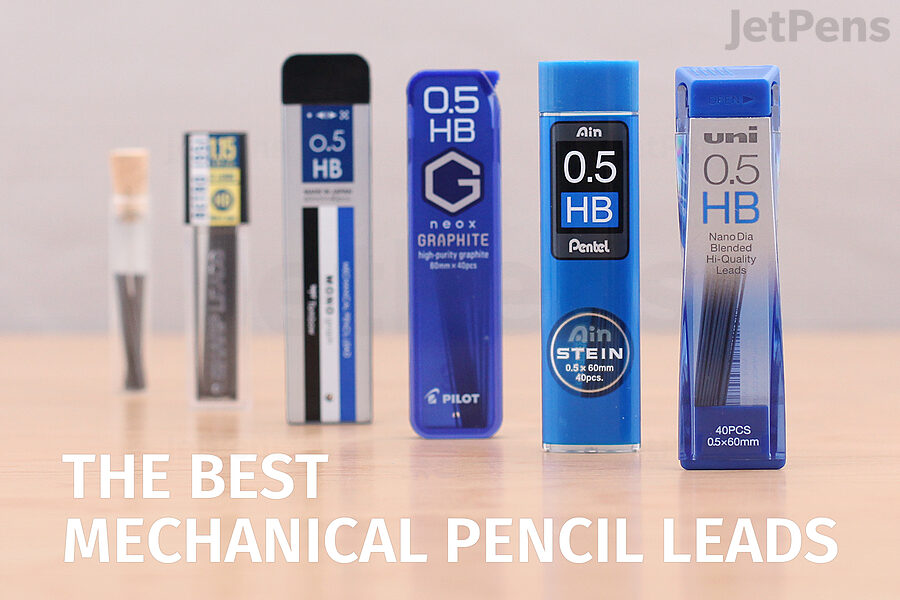
When it comes to mechanical pencils, the right lead can make all the difference between a delightful writing experience and one that is merely mediocre. Whether you're using a 40-cent Bic or a $400 Montblanc, it's the lead that determines how a pencil writes. Let's take a look at our top pencil lead recommendations, after which we'll delve into a more extensive comparison of all our lead brands.
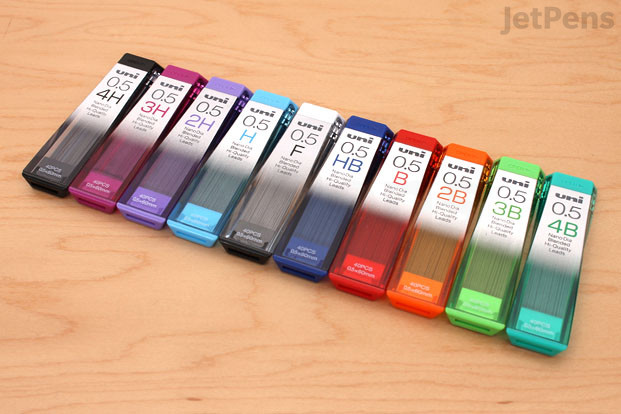
We love Uni NanoDia leads because they have the best overall balance of smoothness, darkness, break-resistance, and longevity—making them a great choice for any task. The name NanoDia comes from the nano-diamond particles used in the lead to provide better strength and smoothness than typical leads. They are available in sizes from 0.3 mm to 0.9 mm and a variety of hardness grades (4H to 4B in 0.5 mm size), so you can enjoy them no matter your pencil and lead grade preferences.
Table of Contents
- Top Choice
- Other Top Choices
- Best for Writing and Drawing
- Best for Math and Diagrams
- Best Colored Leads
- Choosing the Right Lead Size and Grade
- Other Considerations
- Smoothness
- Darkness
- Break Resistance
- Longevity
- Erasability
- Smudge Resistance
- Specialty Leads
- How We Approach Research & Testing
- Final Thoughts
Other Top Choices
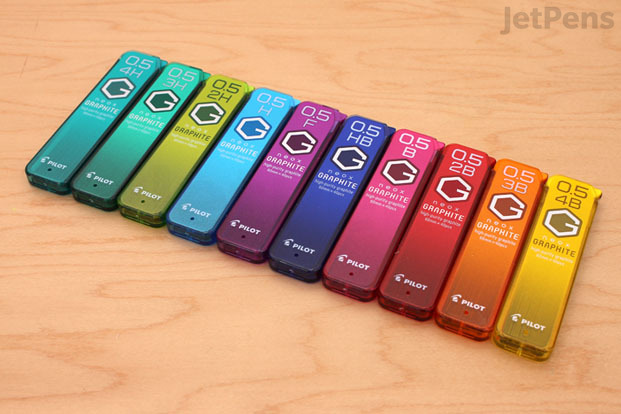
Pilot Neox leads are smoother and darker than the NanoDia leads, with a lubricated feel that makes for an effortless writing and sketching experience. This is due to the Neox leads' high-purity graphite. With fewer impurities in the lead, the layered graphite sheets that make up the lead are able to slide onto the page with minimal resistance. Neox leads are also among the easiest to erase, making them great for correcting mistakes or adding highlights to drawings.
The tradeoff for this luxurious smoothness and effortless erasability is reduced longevity—in our testing, we found that Neox leads could only write about two-thirds as much as NanoDia leads before getting used up.
Like the NanoDia leads, Neox leads come in a wide range of sizes and hardness grades.
Alternatively, Rotring Tikky leads are the smoothest leads we have and just as dark as the Neox leads. They get used up much faster than even the Neox leads, however, and they're less break resistant, less easily erasable, and only come in HB.
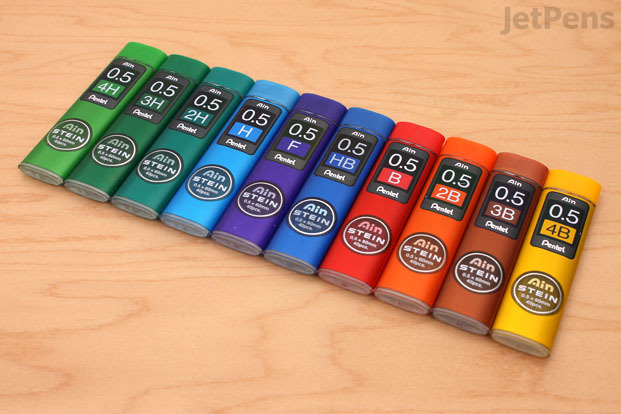
Super-smooth leads may be great for free-flowing words and drawings, but for precise math formulas and diagrams, we prefer leads with a bit more tooth. Pentel Ain Stein leads give just the right amount of tactile feedback to feel pleasant yet under control. They also have better smudge resistance than the Neox or NanoDia leads—an important quality when you're carrying important notes and assignments around in a binder.
Ain Stein leads come in the widest selection of grades and sizes, including the ultra-fine 0.2 mm size (perfect for pairing with the Pentel Orenz 0.2 mm mechanical pencil).
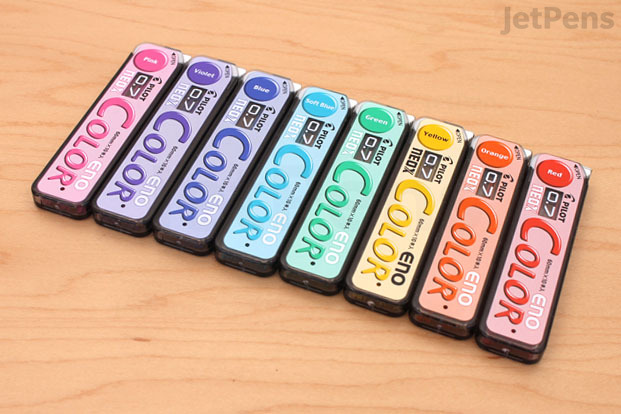
If you want a colorful alternative to normal graphite leads, we recommend Pilot Color Eno Neox leads. They work in any 0.7 mm mechanical pencil and are more erasable and break resistant than most colored leads (though still less than graphite leads). They come in eight colors, including the popular Soft Blue—a favorite among artists for preliminary sketches due to its non-photo-blue properties and ability to be easily edited out of digitally scanned artwork
Check out our guide to colored mechanical pencil leads for an extensive comparison of all our colored leads.
Choosing the Right Lead Size and Grade
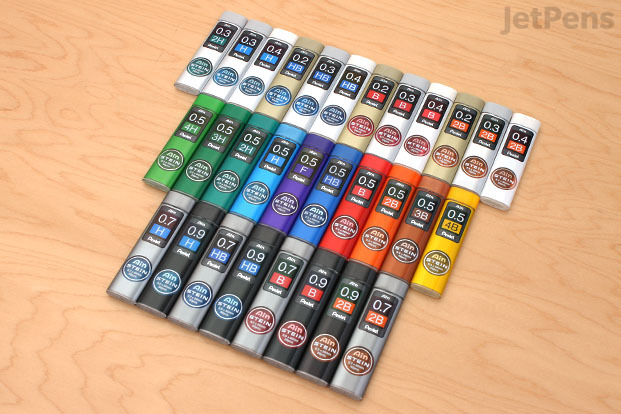
The most important considerations when choosing leads for your mechanical pencil are lead size and lead grade. Unless you pick these two things well, you won't be happy no matter which specific brand or line of leads you choose.
Lead Size
If you're looking for leads to go with a pencil you already own, then this part is easy. Just pick the one that matches your pencil. If you're open to experimenting with new pencil sizes, however, there are some things to consider.
Thinner leads produce sharp, precise lines, but they're also more delicate and get used up faster. Wider leads are smooth and relatively break-resistant, but they aren't as precise and can produce inconsistent line widths as the lead wears down unevenly. (Unless you're using a Kuru Toga pencil, of course.)
0.5 mm and 0.7 mm leads are the most popular, and they're available in the widest selection of brands and lead grades, too. If you're not sure which lead size to pick, these two are a good place to start.
Here are our recommended uses for each lead size:
| Lead Size | Recommended Uses |
|---|---|
| 0.2 mm to 0.4 mm | Extra-fine writing, detailed drawings, compact math equations |
| 0.5 mm | Everyday writing and drawing, math equations, applications that call for a variety of lead grades |
| 0.7 mm | Everyday writing and drawing, heavy-handed writers, applications that call for a variety of lead grades. |
| 0.9 mm and up | Bold writing and sketching, very heavy-handed writers |
For an even better look at all the different lead sizes there are to choose from, be sure to check out our guide here!
Lead Grade
If you grew up in the US, the pencil grade you're probably most familiar with is the classic No. 2 pencil. Mechanical pencil leads use a different scale that can be a bit confusing at first, filled with letters like H, B, and occasionally even F.
But what do lead grades actually mean? Mechanical pencils are made of a mixture of graphite and a binder material like clay. The more graphite is in the lead, the softer, smoother, and darker it will be. Conversely, the more clay is in the lead, the harder, toothier, and lighter it will be. Lead grades are a handy way of distinguishing which balance of these properties each lead has.
The mechanical pencil equivalent of a No. 2 pencil is HB lead, which is also the most popular grade of mechanical pencil lead. If you don't know where to start, you can't go wrong with an HB lead.
If you want an especially smooth and dark lead, we recommend a B or 2B lead. It can be tempting to go all the way out to 4B, but in our experience 4B leads are a bit too soft and prone to smudging for everyday writing.
On the other hand, if you want a slightly firmer, less smudge-prone lead, go for an H or F lead.
You can find more lead-grade-related information and recommendations in our guide to the best lead grade for every application.
Other Considerations
Once you know the lead size and grade you want, the next step is deciding which brand to buy. The lead brand generally doesn't make as much of a difference to the writing experience as the size and grade do, but it's definitely still noticeable. Think of it as an opportunity to fine-tune your lead choice from good to great.
Read on to see which leads came out on top when we tested them head-to-head in six different categories. All of our tests were done with 0.5 mm HB leads, so please note that your experience with other lead sizes and grades may vary.
Smoothness
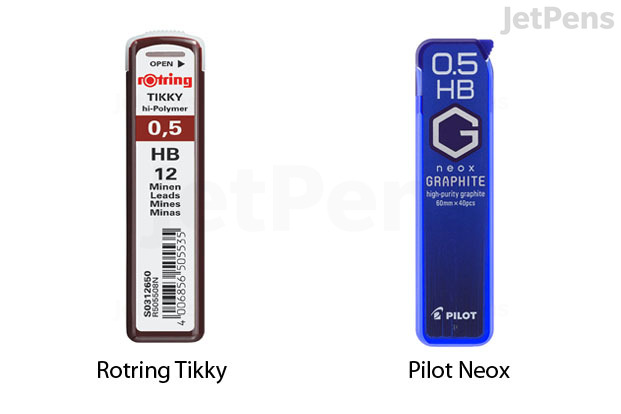
Very smooth leads give a luxurious writing and sketching experience, but for more precise work like math homework and technical drawing, we prefer the control offered by leads with more feedback. And as we mentioned earlier, a lead's hardness grade has a huge impact on how smooth it is. If you want to increase the smoothness or feedback of your pencil, try using a softer or harder lead grade, respectively.
Click here to see our full testing results for lead smoothness.
Click here to see our full testing results for lead smoothness.
Darkness
Click here to see our full testing results for lead darkness.
Click here to see our full testing results for lead darkness.
Break Resistance
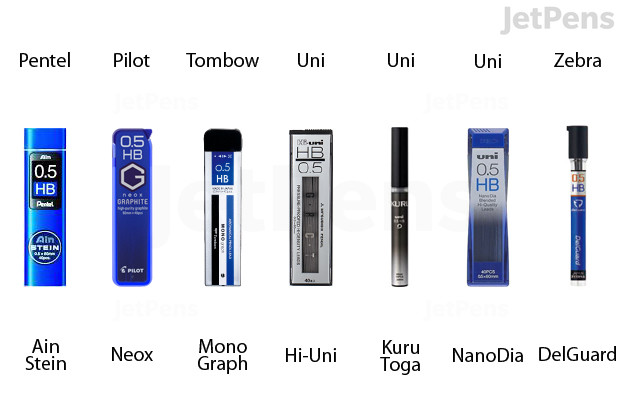
Another effective way to reduce lead breakage is with a lead-guarding mechanical pencil like the Zebra DelGuard.
Click here to see our full testing results for break resistance.
Click here to see our full testing results for break resistance.
Longevity
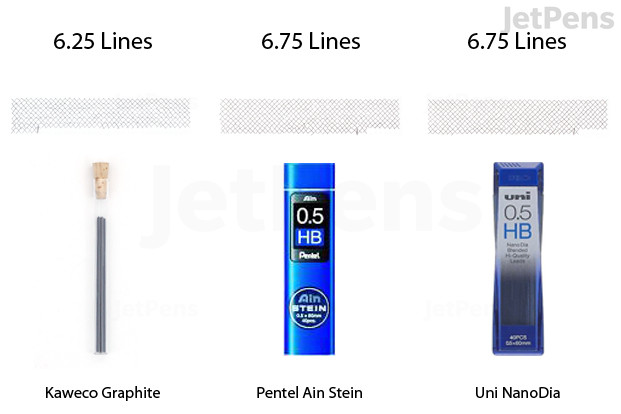
Some leads last longer than others before wearing down. In addition to being cost efficient, longer-lasting leads also save you from having to extend the lead as often.
We found the longest-lasting leads to be the Pentel Ain Stein, Uni NanoDia, and Uni Kuru Toga leads. The Kaweco leads actually lasted slightly longer than the Kuru Toga leads in our testing, but the Kaweco leads break so much more easily that all but the lightest-handed writers will probably get less mileage out of them in the real world.
Click here to see our full testing results for longevity.
Click here to see our full testing results for longevity.
Erasability
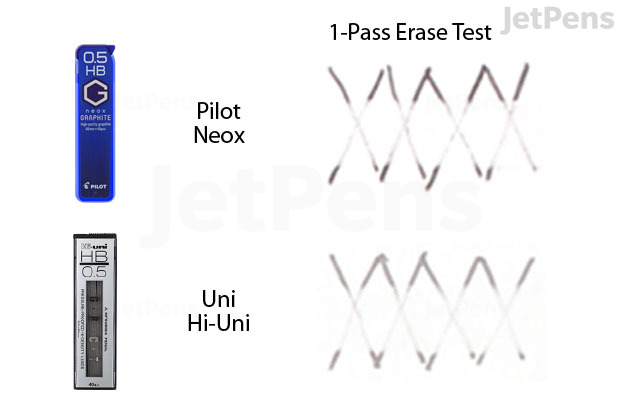
All of the leads we tested had good erasability, but the easiest to erase were the Pilot Neox, Uni Hi-Uni, and Zebra DelGuard leads. Some leads, like the Kaweco and Staedtler Mars leads, took a bit more effort to erase than the others did, but they all erased cleanly in the end.
Our testing was done using a Uni Boxy eraser and ordinary copy paper. We tested how cleanly each lead erased with a single pass of the eraser and when fully erased using as many passes as necessary.
Click here to see our full testing results for erasability.
Click here to see our full testing results for erasability.
Smudge Resistance
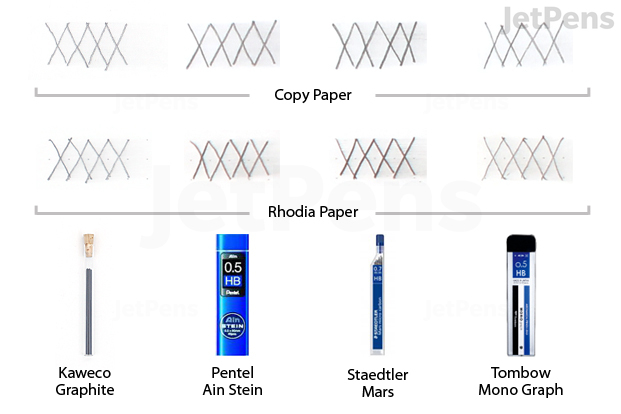
Smudging can be caused by accidentally rubbing the page with the palm of your hand or simply by pages rubbing against each other in a notebook or stack of papers. All of the leads we tested smudged to some degree, but the ones that smudged the least were the Kaweco and Tombow Mono Graph leads, followed by the Pentel Ain Stein leads.
Click here to see our full testing results for smudge resistance.
Click here to see our full testing results for smudge resistance.
Specialty Leads
There are a few leads we carry that aren't necessarily important for everyone but have some interesting features that are worth mentioning.
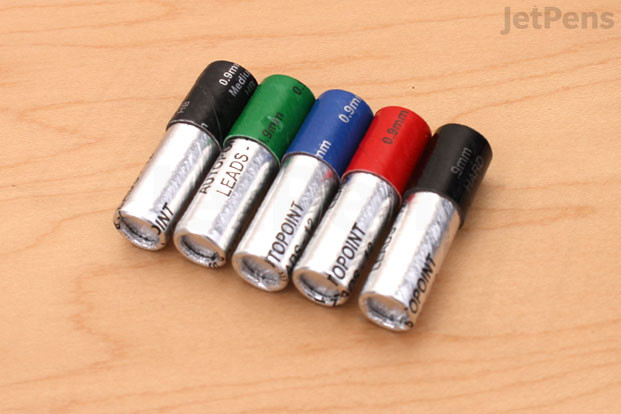
Made for Autopoint's unique twist-action pencils, Autopoint leads are shorter than typical leads—about 35 mm instead of the standard 60 mm. You can use them in regular mechanical pencils too, but since most pencils can't use the last 10 mm of each lead, you'd be wasting a lot of lead by doing so.
Compared to other leads, Autopoint leads have a bit more feedback, better smudge resistance, and very good erasability.
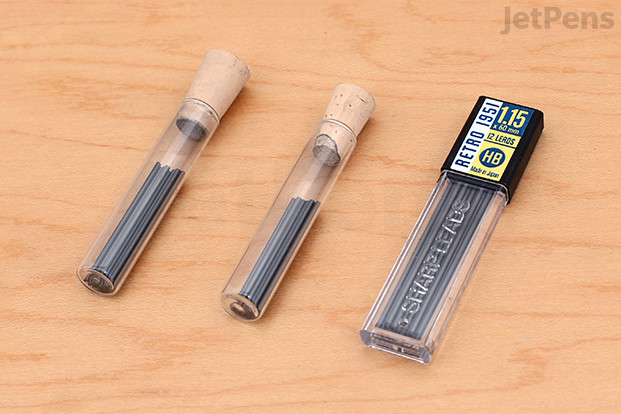
1.1 mm, 1.15 mm, or 1.18 mm—they go by different names depending on the brand, but they're all actually the same width. Not many pencils use these leads nowadays, but they were very common throughout the early and mid 20th century. If you have a vintage mechanical pencil that uses thick leads, there's a good chance these leads will work with it.
(If you try them and they're a bit too thick, try a 0.9 mm lead instead.)
The Retro 51 leads are the darkest and smoothest of these leads, while the E+M and Kaweco leads are lighter and have more feedback.
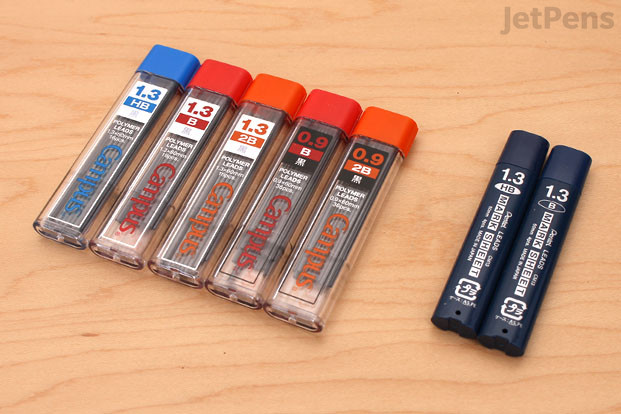
These wide leads give a smooth, bold writing experience closer to that of a wooden pencil than a typical mechanical pencil. They're also great for quickly filling in Scantron-style fill-in-the-blank answer sheets.
Both the Kokuyo Campus and Pentel Mark Sheet leads are smooth and dark, but the Mark Sheet leads are easier to erase—a good thing if you need to change an answer on a test sheet.
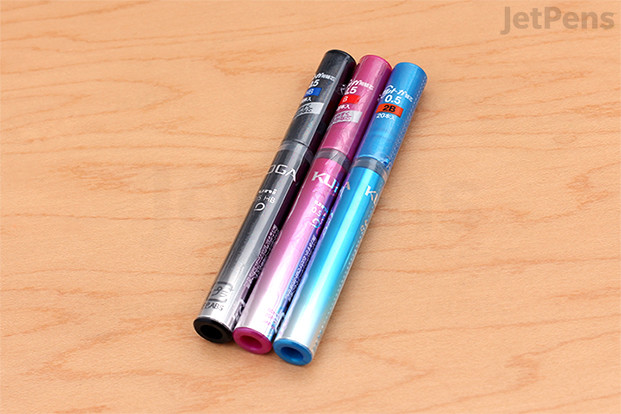
Kuru Toga leads are similar to our favorite NanoDia leads, but they hide a unique feature in their cores. Unlike regular leads, which have a single hardness all the way through, Kuru Toga leads are softer on the outside and harder on the inside. When used in a Kuru Toga auto lead rotation pencil, this helps the lead to form and retain a sharp point more easily.
Even if you don't use a Kuru Toga pencil, however, the Kuru Toga leads still hold a point well, especially if you rotate your pencil occasionally while using it. (Many people do this without even realizing it.) You can use Kuru Toga leads in any mechanical pencil as long as it's the right size.
Our writers draw on their personal expertise, consult our in-house subject matter experts, and do extensive research to make our guides as accurate and comprehensive as possible. We then test every finding that makes it through the research stage. Only the techniques and tools whose performance we personally confirm make it into our guides as recommendations.
Final Thoughts
If you've spent time picking out a great mechanical pencil, why not take a minute and pick out a great lead to let it write its best? If you're still on the lookout for your perfect pencil, be sure to check out our guide to the best mechanical pencils and our beginner's guide to mechanical pencils. We also have a guide specifically dedicated to pencils that will protect your leads from breaking as you write. And lastly, if you want to add some color to your mechanical pencil game, take a look out our guide to the best colored mechanical pencil leads.
Have you got any lingering lead-related questions? Would you like to give a shout-out to your favorite mechanical pencil lead? We'd love to hear it in the comments below!
best lead for mechanical pencils
Source: https://www.jetpens.com/blog/The-Best-Mechanical-Pencil-Leads/pt/887
Posted by: williamsontheresobted.blogspot.com

0 Response to "best lead for mechanical pencils"
Post a Comment